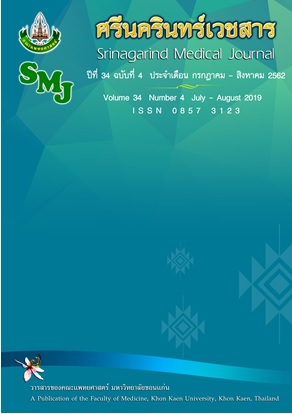Entrapment of Posterior Divisions of the Mandibular Nerve by the Lateral Pterygoid Muscle
Keywords:
Branches of the posterior division of the mandibular nerve; Nerve entrapment, Lateral pterygoid muscleAbstract
Background and Objectives: The branches of the posterior division of the mandibular nerve (MNsP) are the important nerves which supply the infratemporal fossa and oral cavity. Clinically, the nerve entrapment by muscle leads to numbness, pain, or both symptoms in the respective area of nerve distribution. It could also be pain during speaking or oral movements. Therefore, this study aimed to investigate the variations of MNsP entrapment by lateral pterygoid muscle (LPM) in Thai embalmed cadavers.
Methods: One hundred hemi-sectioned heads of Thai embalmed cadavers were carefully dissected to observe MNsP distribution and the inner surface of the LPM. The patterns of nerve entrapments were recorded and photographed.
Results: The results showed that the MNsP variation (entrapment) type by LPM (superior head) was found as 9% (9 cases, males=7, females=2).In the rest 91 cases (91%; 91 cases, males=45 and females=46), the patterns of MNsP were found to be normal type and they were not entrapped by superior or inferior head of LPM.
Conclusions: The incidence of MNsP entrapment by superior head of LPM in Thai embalmed cadavers was approximately 9%. This information may support the theory that some cases such as temporomandibular joint syndrome, persistent idiopathic facial pain, and myofascial pain syndrome may result from entrapment neuropathies of MNsP in the infratemporal fossa.
References
2. Piagkou M, Domestica T, Piagkos G, loannis C, Skandalakis P, Johnson EO. The Mandibular Nerve: The Anatomy of Nerve Injury and Entrapment. Maxillofacial Surgery 2012: 71-83.
3. Allum AES, Khalil AAF, Eltawab BA, Wu WD, Chang KV. Ultrasound-Guided Intervention for Treatment of Trigeminal Neuralgia: An updated Review of Anatomy and Techniques. Research and Management 2018: 1-6.
4. Kang HC, Kwak HH, Park HD, Kang MG, Kim HJ. Topographic Anatomy of the Mandibular Nerve Branches Distributed on the Lateral Pterygoid Muscle. Korean J Phys Anthropol 2002; 15: 79-93.
5. Piagkou M, Domestica T, Piagkos G, Giorgios A, Panagiotis S. Lingual Nerve Entrapment in Muscular and Osseous Structures. Int J Oral Sci 2010; 2: 181-9.
6. Piagkou M, Domestica T, Skandalakis P, Johnson EO. Functional Anatomy of the Mandibular Nerve: Consquences of Nerve Injury and Entrapment. Clin Anat 2011; 24: 143-50.
7. Peuker ET, Fischer G, Filler TJ. Entrapment of the Lingual Nerve Due to an Ossified Pterygospinous Ligament. Clin Anat 2001; 14: 282-4.
8. Kim SY, Hu KS, Chung IH, Lee EW, Kim HJ. Topographic anatomy of the lingual nerve and variations in communication pattern of the mandibular nerve branches. Surg Radiol Anat 2004; 26: 128-35.
9. Nayak SR, Rai R, Khrisnamurthy A, Prabhu LV, Ranade V, Mansur DI, et al. An usual course and
entrapment of the lingual in the infratemporal fossa. Bratisl Lek Listy 2008; 109: 525-7.
10. Gonzalez JA, Escoda CG. Sensory disturbances of buccal and lingual nerve by muscle compression: A case report and review of the literature. J Clin Exp Dent 2016; 8: e93-6.
11. Piagkou M, Domestica T, Piagkos G, Ioannis C, Skandalakis P, Johnson E. The Mandibular Nerve: The Anatomy of Nerve Injury and Entrapment. Maxillofacial Surgery, Prof. Leon Assael (Ed); 2012: 83.




